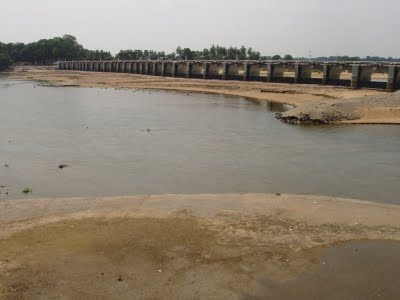Many a times(4-5 times)I have passed through the kalanai bridge in Trichy and my MIL would mention to my children ‘Idhu daan chozha kalathu Kalanai (this is the stone dam of chola times). Whenever she said that, It never occurred to me until this time, that I was overlooking a standing testimony of the first century engineering skill which is still functional today in the 21st century.
Kalanai or it's english name ‘The grand anicut’ is ancient India’s engineering marvel built in the first century A.D (source: sangam literature) by the chola king Karikala chola.
This is built across River Kaveri near Trichy. The dam gives raise to a series of water canals like vennar, vettar, arasalar, kodamurutti etc., and irrigates the whole of Thanjavur district of the Cauvery delta which is called the ‘Granary of south India’ for its rich green paddy fields, plaintain plantations, sugarcane fields, mango orchards etc.,
If not for the foresightedness of the chola king, the whole Thanjavur region would be barren since there is no other major water source here.
Today, When cement structures built with advanced technology by esteemed companies fall like a pack of cards,(most of you will remember, an under construction bridge fell a couple of years back in Hyderabad @ punjagutta killing many), this dam much before the invention of cement was built with loose rock set in mud, well levitated clayey soil, stiffened with lots of wood and stone shutters. This has withstood many floods and is still functioning to date. The outer and inner sides of the dam were lined with finely cut granite blocks and were interlocked at the lower level while at higher level, the lining was roughrock set in lime paste. The whole structure is then lined with a thin layer of lime plaster.
The dam was rebuilt about three times till the ancient chola engineers were satisfied with the correct size,length, breadth, height, volume, force of water in storage behind the structure.
In the 1800's minor modifications and alterations were done by European engineers of British India. The stone shutters were removed in 1830 and replaced by Iron shutters, chains, roller wheels by an irrigation engineer of the British East India company Sir Arthur Cotton. He was awe struck to find a structure built of lime sand mix still functioning. He made modifications to the dam by increasing the storage of water by three fold after working the specifications scientifically. Based on the study and materials used here, he built barrages and dams across river Godavari. This helped him to become India’s greatest Irrigation engineer. But he in all humility never took the glory, instead he highlighted the skills of the ancient chola engineers from whom he learned his work. This also became a model for many European enginners later on. Later on many modifications took place periodically, the latest being in 2006.
Today this functional dam has become a picnic spot. A beautiful park with statues of Karikala cholan, Sage Agasthya and the crow depicting the origin of Kaveri etc adorn the park.
Many families enjoy by barbecuing the fresh fishes caught by them and cooking food on chulhas. The washermen of the city also use the place to wash the clothes close to the dam.
The channel gates have been thrown open on june 9th and now it must be gushing with water. I visited it in May when it was peak summer in Trichy called kathiri veyil, so the river was almost dry and the water was not released from Mettur dam.
One must visit this place between July- December when the river water swells. In the tamil month of aadi and on the 18th day(mid july) it flows to its full glory and tamils celebrate a festival called ' padinettam perukku' or 'aadi 18' by offering puja to River Kaveri, rejoicing with a dance called 'Kummi' and feasting on mixed rice like lemon rice, curd rice, coconut rice on the banks of river Kaveri.
I wonder why this structure has not got the honour it deserves, thankfully this engineering miracle is now on the way to be in the safe hands of UNESCO's World heritage site for being the oldest engineering structure to still function albeit repaired periodically. The whole area needs maintenance. The dry water channels(summer) are strewn with plastic wastes, tin cans, tetrapaks etc.,
When you drive out of the place, after the bridge you find lot of thennamthoppu( palm groves), vazhathoppu( plaintain plantations) and mango orchards like thathachariyar gardens. The harvested mangoes are sold on either side of the road giving rise to the name of the road as Mambhaza salai( the road of ripe mangoes). Sadly many acres of such land are gobbled by apartments.
Below are some clicks,though I have not done justice to the place with my images.
Most pics of the river were taken from a moving vehicle,it might lack clarity.

Sage Agasthya and the crow ( the originator of River Kaveri and the Ancient language of Tamizh)

A view of the dam

River Kaveri, it would swell to its capacity and beyond in july, august
 The bridge to trichy
The bridge to trichy

River Kollidam a tributary of Kaveri


The plaintain plantations

The palm groves
Information courtesy on Sir arthur cotton: NTV news.
gives goosepimples even to read abt this.. :) feels so proud..history has always been my fav subject and cholas and guptas are my fav monarchs. u DO paint a vivid picture. Wikipediala podalam unga blogsa :)
ReplyDeleteTouched by your comment gils, thank you.
ReplyDeleteThere is so much to learn about humanity from history. ME too like history.
awesome pics!
ReplyDeleteVery informative and good pictures. Yes we do have many things to be proud of.
ReplyDeleteNice article. Unlike our today's politicians (2G Raja) Chola's are great rulers and visioneries. I request all visitors to Kallanai to behave responsibily. In the name of picnic, donot litter the kallanai.
ReplyDelete